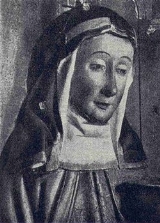
Catherine of Sweden
Encyclopedia
Saint Catherine of Sweden, Katarina av Vadstena or Catherine of Vadstena (c. 1332 – 24 March 1381) has been called the patron saint of protection against abortion
and miscarriage
. Her father was Ulf Gudmarsson, Lord of Ulvåsa, and her mother was the better known Saint Birgitta (in their lifetime known as Birgitta Birgersdotter of Finsta).
At the age of about twelve or thirteen she married Lord Eggert van Kyren, a young half-Swedish, half-Westphalian nobleman, with whom she took a vow of celibacy
. Catherine accompanied her mother to Rome
in 1349, and soon upon arrival heard news of her husband's death. Catherine is said to have written a devotional work entitled Consolation of the Soul (in medieval Swedish Siælinna tröst, or Själens tröst in modern Swedish), a dated copy from 1407 is still in existence.
Before her death, Catherine became head of the Brigittine convent at Vadstena Abbey
, which was founded by her mother. In 1484, Pope Innocent VIII
gave permission for Catherine's veneration as a saint and her feast was assigned to 22 March in the Roman martyrology. St Catherine is generally represented with a hind
at her side, which is said to have come to her aid when unchaste youths tried to rape her.
In 1488, Pope Innocent VIII gave permission for the translation
of her relics in Vadstena
. The beatification
and canonization
process (which also documented the required miracles) was never completed because of the Protestant reformation
.
Abortion
Abortion is defined as the termination of pregnancy by the removal or expulsion from the uterus of a fetus or embryo prior to viability. An abortion can occur spontaneously, in which case it is usually called a miscarriage, or it can be purposely induced...
and miscarriage
Miscarriage
Miscarriage or spontaneous abortion is the spontaneous end of a pregnancy at a stage where the embryo or fetus is incapable of surviving independently, generally defined in humans at prior to 20 weeks of gestation...
. Her father was Ulf Gudmarsson, Lord of Ulvåsa, and her mother was the better known Saint Birgitta (in their lifetime known as Birgitta Birgersdotter of Finsta).
At the age of about twelve or thirteen she married Lord Eggert van Kyren, a young half-Swedish, half-Westphalian nobleman, with whom she took a vow of celibacy
Celibacy
Celibacy is a personal commitment to avoiding sexual relations, in particular a vow from marriage. Typically celibacy involves avoiding all romantic relationships of any kind. An individual may choose celibacy for religious reasons, such as is the case for priests in some religions, for reasons of...
. Catherine accompanied her mother to Rome
Rome
Rome is the capital of Italy and the country's largest and most populated city and comune, with over 2.7 million residents in . The city is located in the central-western portion of the Italian Peninsula, on the Tiber River within the Lazio region of Italy.Rome's history spans two and a half...
in 1349, and soon upon arrival heard news of her husband's death. Catherine is said to have written a devotional work entitled Consolation of the Soul (in medieval Swedish Siælinna tröst, or Själens tröst in modern Swedish), a dated copy from 1407 is still in existence.
Before her death, Catherine became head of the Brigittine convent at Vadstena Abbey
Vadstena Abbey
Vadstena Abbey was the motherhouse of the Bridgettine Order, situated on Lake Vättern, in the Diocese of Linköping, Sweden. The abbey started as one of the farms donated by the king, but the town of Vadstena grew up around it...
, which was founded by her mother. In 1484, Pope Innocent VIII
Pope Innocent VIII
Pope Innocent VIII , born Giovanni Battista Cybo , was Pope from 1484 until his death.-Early years:Giovanni Battista Cybo was born at Genoa of Greek extraction...
gave permission for Catherine's veneration as a saint and her feast was assigned to 22 March in the Roman martyrology. St Catherine is generally represented with a hind
Hind
The word Hind may refer to:* A female red deer* al-Hind , also Hind - The people of India or Indian subcontinent...
at her side, which is said to have come to her aid when unchaste youths tried to rape her.
In 1488, Pope Innocent VIII gave permission for the translation
Translation (relics)
In Christianity, the translation of relics is the removal of holy objects from one locality to another ; usually only the movement of the remains of the saint's body would be treated so formally, with secondary relics such as items of clothing treated with less ceremony...
of her relics in Vadstena
Vadstena
Vadstena is a locality and the seat of Vadstena Municipality, Östergötland County, Sweden, with 5,612 inhabitants in 2005. From 1974 to 1979 Vadstena was administered as part of Motala Municipality....
. The beatification
Beatification
Beatification is a recognition accorded by the Catholic Church of a dead person's entrance into Heaven and capacity to intercede on behalf of individuals who pray in his or her name . Beatification is the third of the four steps in the canonization process...
and canonization
Canonization
Canonization is the act by which a Christian church declares a deceased person to be a saint, upon which declaration the person is included in the canon, or list, of recognized saints. Originally, individuals were recognized as saints without any formal process...
process (which also documented the required miracles) was never completed because of the Protestant reformation
Protestant Reformation
The Protestant Reformation was a 16th-century split within Western Christianity initiated by Martin Luther, John Calvin and other early Protestants. The efforts of the self-described "reformers", who objected to the doctrines, rituals and ecclesiastical structure of the Roman Catholic Church, led...
.

